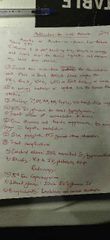![]()
![]()
![]()
Use LEFT and RIGHT arrow keys to navigate between flashcards;
Use UP and DOWN arrow keys to flip the card;
H to show hint;
A reads text to speech;
28 Cards in this Set
- Front
- Back
|
What organs are drained by the portal vein |
Stomach Spleen Pancreas Intestines |
|
|
Functions of the liver |
Formation of bile and secretion Nutrients and vitamins metabolism Inactivation of various substances Synthesis of plasma proteins(albumin,acute phase,clotting factors, steroid binding and other hormone binding proteins) Immunity |
|
|
What are the groups of clinical features of liver disease |
Hepatocellular Cholestatic Mixed |
|
|
How do you evaluate a patient with liver disease? |
Establishing the cause Estimating the severity or grading(mild,moderate,severe,active or inactive) Establish the disease stage(staging) |
|
|
What are the typical symptoms of liver disease |
General: fatigue,weakness,nausea,poor appetite Liver specific symptoms: Jaundice Dark urine Light stools Itching Adominal pain Bloating |
|
|
At what bilirubin level is jaundice seen? |
Bilirubin level greater than 2.5mg/dl |
|
|
How much alcoholic use can lead to alcoholic liver disease? |
Greater than two drinks per day in females and greater than 3 drinks per day males |
|
|
What is alcoholism |
It is defined by behavorial patterns and consequences of alcohol intake not by amount |
|
|
How do you assess alcoholism? |
Abuse and dependency |
|
|
What is alcohol abuse? |
Repetitive pattern of drinking alcohol that has adverse effect on social,family,occupational or health status. |
|
|
What is alcohol dependence? |
Alcohol seeking behavior despite its adverse effects |
|
|
How do you assess abuse or dependence to alcohol |
Use the CAGE questions |
|
|
What are the physical findings of early disease? |
Icterus Hepatomegaly Hepatic tenderness Splenomegaly Spider angiomata Palmar erythema Skin excoriation |
|
|
What are the physical findings of advanced liver disease |
Ascites Muscle wasting Edema Dilated abdominal veins Hepatic fetor Aterixis Mental confusion Stupor Coma |
|
|
In male patients with cirrhosis related to alcohol use what are the signs of hyperestrogenemia |
Gynecomastia Testicular atrophy Loss of male pattern hair distribution |
|
|
What is hepatic failure? |
Occurrence of signs and symptoms of hepatic encephalopathy in a person with severe acute or chronic liver disease |
|
|
What are other signs can be elicited in a liver disease patient? |
Umbilical hernia in from ascites Hydrothorax Prominent veins over abdomen Caput medusae Widened pulse pressure Hepatopulmonary syndrome |
|
|
What is the classical triad of hepatopulmonary syndrome |
Liver disease Hypoxemia Pulmonary arteriovenous shunting |
|
|
What are the clinical features of hepatopulmonary syndrome |
Platypnea: Shortness of breath relieved when lying down made worse when standing or sitting Orthodeoxia: Shortness of breath and oxygen desaturation that occur paradoxically upon assumption of upright position |
|
|
What are the differential diagnosis of liver disease? |
Inherited hyperbiluribinemia: Crigler-Najjer Gilbert Syndrome Dubin-Johnson Rotor syndrome Viral hepatitis(CMV,EBV,ADENOVIRUS,HERPES VIRUS) IMMUNE AND AUTOIMMUNE: Primary sclerosing cholangitis Primary biliary sclerosis Autoimmune hepatitis GENETIC LIVER DISEASE: Alpha 1 antitrypsin defeciency Hemochromatosis Wilson's disease Alcoholic liver disease(fatty liver) Steatohepatitis Mycobacterium avium Tuberculosis Sarcoidosis CHOLESTATIC SYNDROMES Biliary atresia Jaundice of sepsis Cholecystitis DRUG INDUCED LIVER DISEASE SteatosisSteatohepatitisMycobacterium aviumTuberculosisSarcoidosisCHOLESTATIC SYNDROMESBiliary atresiaJaundice of sepsisCholecystitisDRUG INDUCED LIVER DISEASEHepatocellular(Isoniazid, acetaminophen)Cholestatic pattern(methyltestosterone)Mixed(sulfonamides,phenytoin)MethotrexateBudd Chiari syndromeHepatocellular Carcinoma Hepatocellular(Isoniazid, acetaminophen) Cholestatic pattern(methyltestosterone) Mixed(sulfonamides,phenytoin) Methotrexate Budd Chiari syndrome Hepatocellular Carcinoma |
|
|
Lab tests to confirm common causes of chronic liver disease |
Hepatitis C- Anti-HCV Alcoholic liver disease- history of abuse and dependency NASH-Ultrasound or CT Hepatitis B- HbsAg and the rest Autoimmune hepatitis- ANA and Smooth muscle antibodies, elevated IgG Sclerosing cholangitis- P-ANCA Biliary cholangitis-mitochondrial antibodies, elevated IgM Hemochromatosis- serum ferritin and iron studies Wilson disease- serum ceruloplastin, hepatic copper levels, HFE gene mutations |
|
|
What tests comprise the liver function tests? |
ALT, AST, ALP, TBIL , DIRECT BILURIBIN , PT, ALBUMIN |
|
|
Triggers of hepatic encephalopathy |
GI bleeding Over diuresis Dehydration Infection Electrolyte imbalance Constipation Hypokalemia Increased dietary proteins |
|
|
Major complications of cirrhosis |
Portal hypertension:GE varices, Spontaneous bacterial peritonitis, Ascites, Hypersplenism, Gastropathy Coagulopathy:Fibrinolysis, Factor defeciency, Thrombocytopenia Hepatorenal syndrome Hepatopulmonary syndrome Hematological:Anemia, Hemolysis, Neutropenia, Thrombocytopenia Malnutrition Bone disease: Osteopenia, osteoporosis, osteomalacia |
|
|
Management of acute variceal bleeding |
Resuscitation with IVF and blood products Medical management with vasoconstrictive agents(octreotide) Balloon tamponade-Sengstaken-Blakemore tube Endoscopy |
|
|
What is hepatorenal syndrome |
Form of functional renal failure without renal pathology that occurs in patients with advanced cirrhosis or acute liver failure |
|
|
Manage hepatic encephalopathy |
Hydration and correct electrolytes Correct precipitating factors Lactulose |
|
|
Managing a patient with liver failure |

|

